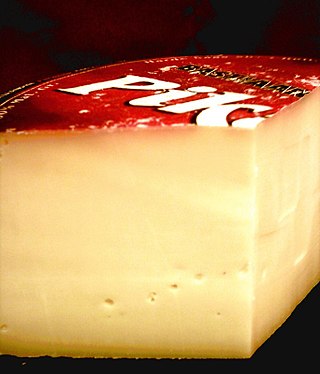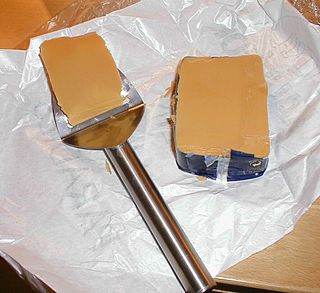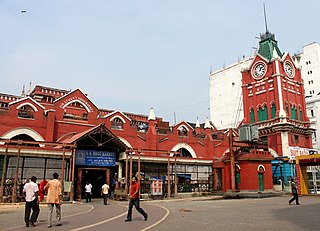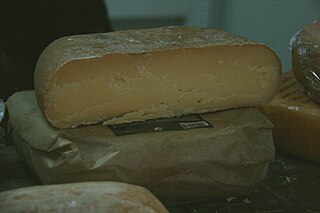Related Research Articles

Cheddar cheese is a natural cheese that is relatively hard, off-white, and sometimes sharp-tasting. It originates from the English village of Cheddar in Somerset, southwest England.

Gouda cheese is a creamy, yellow cow's milk cheese originating from the Netherlands. It is one of the most popular and produced cheeses worldwide. The name is used today as a general term for numerous similar cheeses produced in the traditional Dutch manner.

Brie is a soft cow's-milk cheese named after Brie, the French region from which it originated. It is pale in color with a slight grayish tinge under a rind of white mould. The rind is typically eaten, with its flavor depending largely upon the ingredients used and its manufacturing environment. It is similar to Camembert, which is native to a different region of France. Brie typically contains between 60% and 75% butterfat, slightly higher than Camembert.

Brunost is a common Norwegian name for mysost, a family of soft cheese-related foods made with whey, milk, and/or cream. The characteristic brown color and sweet taste result from milk sugars being caramelized after boiling. The term brunost is often used to refer to fløtemysost or Gudbrandsdalsost, which are the most popular varieties.

Parmesan is an Italian hard, granular cheese produced from cow's milk and aged at least 12 months or, outside the European Union, a locally produced imitation.

Jarlsberg is a mild cheese made from cow's milk, with large, regular eyes, originating from Jarlsberg, Norway. It is produced in Norway, as well as in Ireland and the US state of Ohio, licensed from Norwegian dairy producers. It is classified as a Swiss-type cheese.

Goat cheese, goat's cheese or chèvre is cheese made from goat's milk. Goats were among the first animals to be domesticated for producing food. Goat cheese is made around the world with a variety of recipes, giving many different styles of cheeses, from fresh and soft to aged and hard.

Camembert is a moist, soft, creamy, surface-ripened cow's milk cheese. It was first made in the late 18th century in Camembert, Normandy, in northwest France. It is sometimes compared in look and taste to brie cheese, albeit with a slightly lower butterfat content than brie's typical 20% – 25% by weight.

Munster, Munster-géromé, or (Alsatian) Minschterkaas, is a soft cheese with a strong taste and aroma, made mainly from milk first produced in the Vosges, between the Alsace-Lorraine and Franche-Comté regions in France. The name "Munster" is derived from the Alsace town of Munster, where, among Vosgian abbeys and monasteries, the cheese was conserved and matured in monks' cellars.

Paneer, also known as panir, is a fresh acid-set cheese common in the cuisine of the Indian subcontinent made from full-fat buffalo milk or cow milk. It is a non-aged, non-melting soft cheese made by curdling milk with a fruit- or vegetable-derived acid, such as lemon juice.

New Market, formerly known as Sir Stuart Hogg Market, is a market complex in Kolkata situated on Lindsay Street at Dharmatala. Although primarily "New Market" referred to the original enclosed market, but in local parlance, the entire shopping area along with the market complex is known as "New Market".

Cheese is a dairy product produced in a range of flavors, textures, and forms by coagulation of the milk protein casein. It comprises proteins and fat from milk. During production, milk is usually acidified and either the enzymes of rennet or bacterial enzymes with similar activity are added to cause the casein to coagulate. The solid curds are then separated from the liquid whey and pressed into finished cheese. Some cheeses have aromatic molds on the rind, the outer layer, or throughout.

There are many different types of cheese. Cheeses can be grouped or classified according to criteria such as length of fermentation, texture, methods of production, fat content, animal milk, and country or region of origin. The method most commonly and traditionally used is based on moisture content, which is then further narrowed down by fat content and curing or ripening methods. The criteria may either be used singly or in combination, with no single method being universally used.

Mallorca cheese is a Spanish cheese made exclusively on the island of Mallorca, one of the Balearic Islands in the Mediterranean Sea. It has Protected Designation of Origin and is made from the pasteurized milk of cows, goats and/or sheep which live on the island. The cheeses are slightly tapering, flat cylinders which measure 12–20 cm (5-8 inches) across and 7-9 cm (3-4 inches) high. They weigh from 750 g to 4 kg (1.5-9 lbs). Mallorca cheese is produced in three types:

Chhena or chhana is a kind of acid-set cheese originating from the Indian subcontinent that is made from water buffalo or cow milk by adding food acids such as lemon juice and calcium lactate instead of rennet and straining out the whey.

Bandel cheese is an Asian cheese that originated in the erstwhile Portuguese colony Bandel in eastern India. It was introduced by the Portuguese and was made by the Mog (Burmese) under Portuguese supervision. At present, Palash Ghosh and his family are the remaining few artisans making the Bandel Cheese. Palash Ghosh and his family are associated with a Kolkata based food company The Whole Hog Deli for marketing the Bandel Cheese.

The Pikauba is a semi-firm cheese, farmer made by hand, in the region Saguenay–Lac-Saint-Jean in Quebec. It takes its name from a river, Pikauba River, that crosses the Laurentides Wildlife Reserve.

Argentine cheese is by far the most produced dairy product in the country, making Argentina the second largest cheese producer in Latin America and among the top 10 cheese-producing countries in the world. In addition, Argentina is the Latin American country that consumes the most cheese, with 12 kilos per capita per year. Production is mainly centered in the provinces of Córdoba, Santa Fe and Buenos Aires, in the Pampas region of the central and east-central parts of the country.
References
- 1 2 "All You Wanted to Know About Local Cheese — Kalimpong to Bandel". The Telegraph. 3 May 2013. Archived from the original on 8 September 2014.
- ↑ "Pairing Indian Wine with Indian Cheese". matchingfoodandwine.com. 19 June 2013.
- ↑ "Say cheese, desi ishtyle". The Times of India. 24 October 2009.